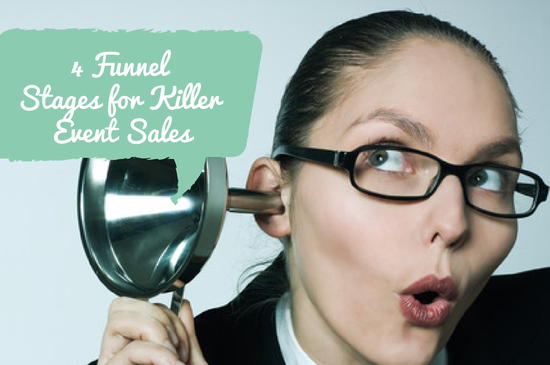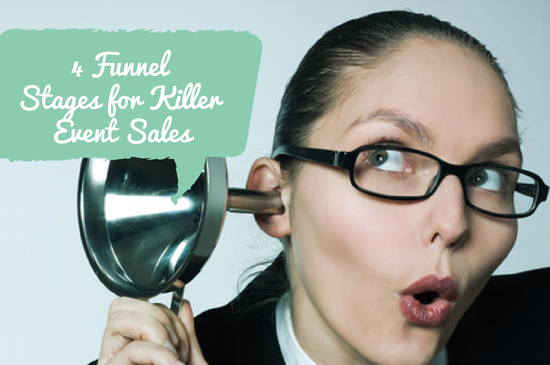Skift Take
focusing on your marketing and sales funnel
If you organise an event or a series of events, especially in a B2B environment, you know how difficult it is to get people to say “yes” and commit to attending (as paying customers in most cases). It’s a tried and tested technique, but simply is guaranteed to maximise your event conversions.

It’s crucial for your event sales team (if you have one) and event marketing team to function as a unit, in order to progress leads through the funnel. So consider this funnel-focused post a friendly nag, to remind you of the importance of working together to turn your leads into fans.
Once you have a satisfied customer base (who will hopefully become your promoters), your job, and that of your event sales team, will become a whole lot easier. This will then give you the chance to focus on the elements of event marketing you really enjoy, rather than desperately chasing down delegates as your event looms.
Top of the Funnel (TOFU) Focus: Prospects
It’s hard to imagine, I know, but some people out there don’t even know about your event yet! Your job, as event marketers, is to make your events visible to those strangers at the top of the funnel. Three key tactics for doing so are:
• Ensure your event website is live as early as possible – if initial content is limited, use previous events and speakers as a basis, and add to this as your programme takes shape. Make it clear who should attend and why and – most importantly – how or where interested parties can register
• Once it is up and running, concentrate on driving potential delegates to your site via a mix of marketing activities such as email, social media, PPC campaigns, traditional advertising, content marketing and some serious networking – both online and offline. Lead generation in event marketing is not just about email, email, email, email and…more email
• Don’t forget to make use of your media partners at this stage – they can help you to expand your reach and access untapped prospects. Ask them to link to your event site, tweet about it and host guest blogs on their own websites (if possible, give partners unique links to your landing pages so you can track just how valuable their contribution is)
Middle of the Funnel (MOFU) focus: Leads
Once you’ve caught the eye of these new folks and they’ve visited your event website, or clicked through an email, it’s time to start pouring prospects into the top of your funnel. The next step in converting these into genuine leads is through the divine trinity of a call to action (CTA), a landing page and a sufficiently detailed form. Then you’ll be ready to feed your hungry sales team.
But, success depends on the quality of the leads. Sticking with the food analogy for a moment, your sales team will not flourish if you feed them ‘junk food’. Think of an initial email click-through as a cheap dirty burger, rather than a wholesome meal. What your sales team needs is a balanced diet.
Give them proper data: names, emails, phone numbers, and profiling – events telesales can be tricky when the information you’re working from is incomplete or vague. If you can determine whether a person is likely to buy, or fits the profile of your ideal attendee, before contacting them (based on details of their company and role within it), you’ll save a huge amount of time. This will become ever more important as your event date draws near, and will allow your sales team to focus on genuine, qualified prospects.
Bottom of the Funnel (BOFU) Focus: Attendees
Now just because you’ve passed the baton to your sales team, doesn’t mean you marketers can put your feet up! Once they get cracking on turning your leads into attendees, you need to get stuck in and work together. Try following up sales calls with a friendly, incentivising, email that reinforces the benefits of signing up to your event, or provides new information – for example on guest speakers, or networking opportunities, and personalise wherever possible.
To maximise results of your discounting strategy (if you have one) work with the sales team to establish who might be most appropriate to receive an offer. But, avoid getting into the habit of lowering ticket prices as the date of your event approaches, as it may cause repeat attendees to register later the following year.
Try limiting the number of reduced priced tickets you offer and create a buzz around registering for your event. If you don’t have the luxury of a supporting sales team, look at what can be automated. This will enable you to nurture leads via email in order to convert them into event delegates.
What Happens at the End of the Funnel? Focus on Fans
Be aware that at the end of the funnel your attendees can still slip out of the spout.. Customer service is an essential skill for frontline sales teams but it is most critical at this touch-point. Listen to your attendees, find out what they want from your event and, where you can, personalise their event experience (read a previous post about the balancing act of optimising event experience).
Instil a sense of loyalty amongst your delegates and turn them into your fan base, then nurture this community via rich content marketing. Remember – when your event comes around again, previous attendees will make up a substantial number of your initial mailing list, so give them a reason to book again with a 365 day event marketing strategy. Loyalty incentives will also play a part, and offering repeat purchase discounts will be more effective than starting from the top of the funnel.
In Conclusion
Event marketing doesn’t stop when you pass the information on to the sales team, or when you convert your leads. This is where the real work begins – maintaining and nurturing the relationship that you’ve just built.
The attendee trusted in you, your event and the value you said you would add, and keeping this relationship afloat is where truly great event marketing can be put into practise.





